BUS703: Analysis of Leadership Coaching, Role-Efficacy, and Trust
VerifiedAdded on 2023/06/11
|11
|2710
|88
Essay
AI Summary
This essay provides a comprehensive review and analysis of an article focusing on leadership coaching, leader role-efficacy, and trust in subordinates. It evaluates the literature review, discusses the mixed-methods research design employed, and assesses the appropriateness of the methods used. The analysis covers the quantitative data collection methods, the quasi-experimental design, and the training provided to leaders. It also critically examines the reliability and validity of the data, suggesting potential improvements such as larger sample sizes and consideration of secondary data sources. The review concludes by highlighting the suitability and importance of the study in contributing to leadership theory and practice, emphasizing the innovative nature of leadership coaching and its potential for revolutionizing leadership development.
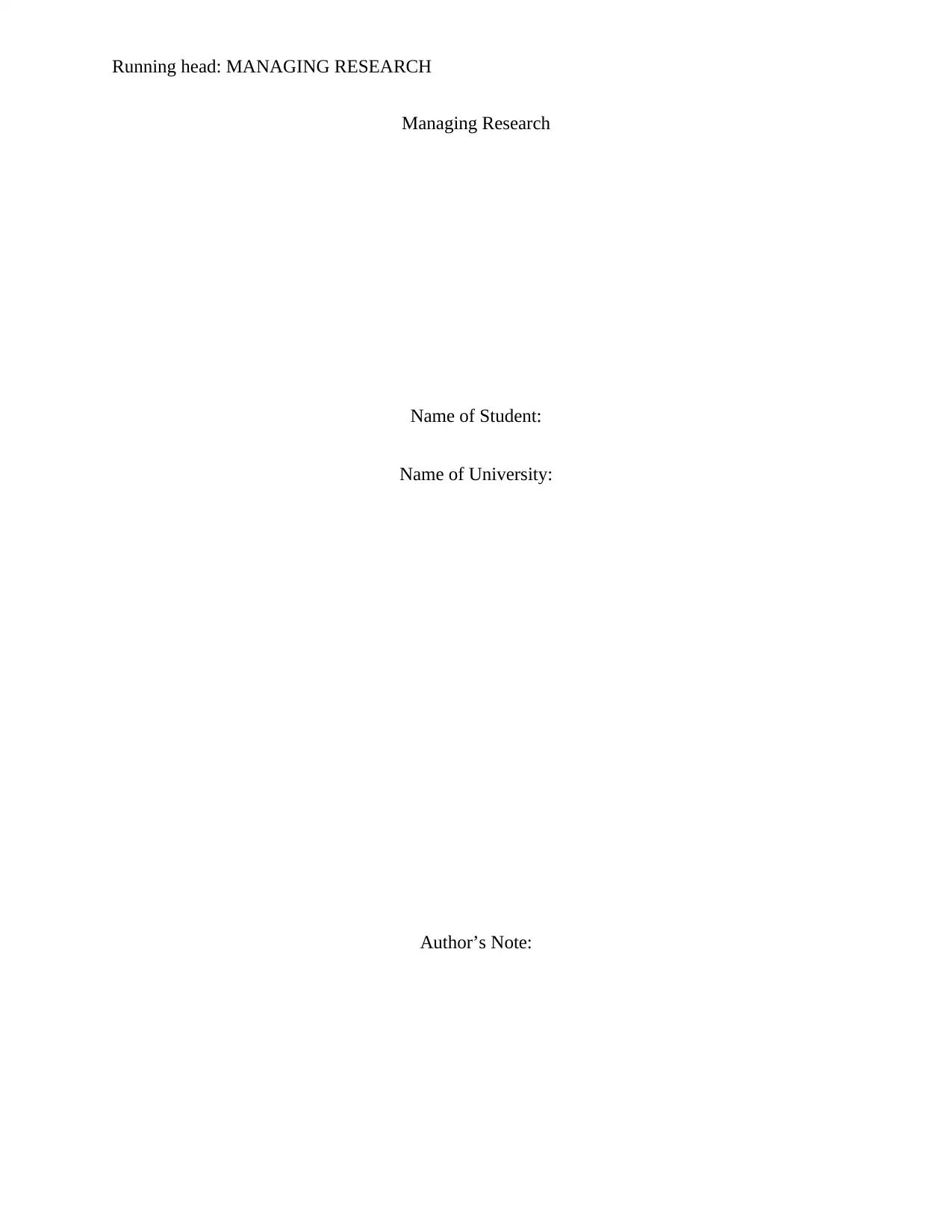
Running head: MANAGING RESEARCH
Managing Research
Name of Student:
Name of University:
Author’s Note:
Managing Research
Name of Student:
Name of University:
Author’s Note:
Paraphrase This Document
Need a fresh take? Get an instant paraphrase of this document with our AI Paraphraser
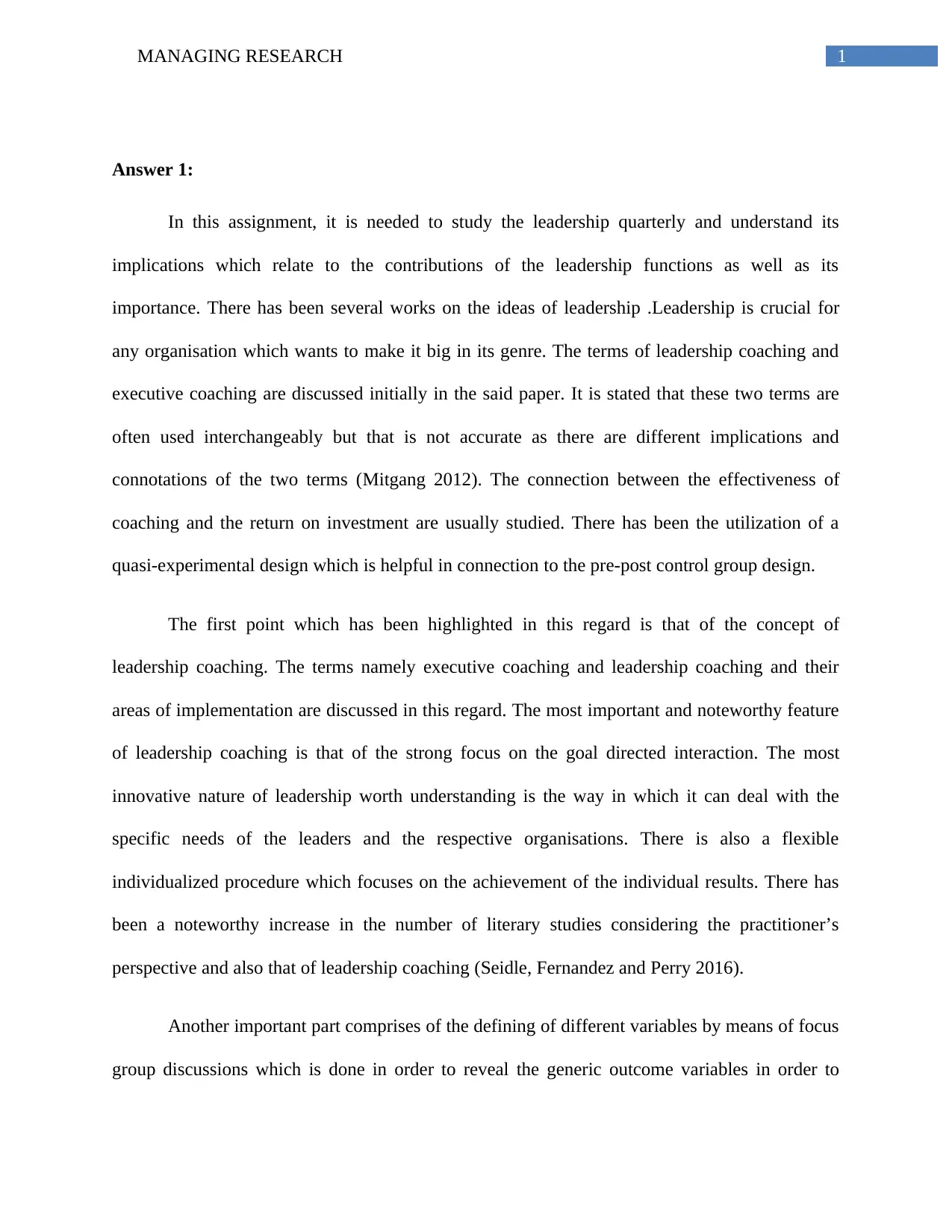
1MANAGING RESEARCH
Answer 1:
In this assignment, it is needed to study the leadership quarterly and understand its
implications which relate to the contributions of the leadership functions as well as its
importance. There has been several works on the ideas of leadership .Leadership is crucial for
any organisation which wants to make it big in its genre. The terms of leadership coaching and
executive coaching are discussed initially in the said paper. It is stated that these two terms are
often used interchangeably but that is not accurate as there are different implications and
connotations of the two terms (Mitgang 2012). The connection between the effectiveness of
coaching and the return on investment are usually studied. There has been the utilization of a
quasi-experimental design which is helpful in connection to the pre-post control group design.
The first point which has been highlighted in this regard is that of the concept of
leadership coaching. The terms namely executive coaching and leadership coaching and their
areas of implementation are discussed in this regard. The most important and noteworthy feature
of leadership coaching is that of the strong focus on the goal directed interaction. The most
innovative nature of leadership worth understanding is the way in which it can deal with the
specific needs of the leaders and the respective organisations. There is also a flexible
individualized procedure which focuses on the achievement of the individual results. There has
been a noteworthy increase in the number of literary studies considering the practitioner’s
perspective and also that of leadership coaching (Seidle, Fernandez and Perry 2016).
Another important part comprises of the defining of different variables by means of focus
group discussions which is done in order to reveal the generic outcome variables in order to
Answer 1:
In this assignment, it is needed to study the leadership quarterly and understand its
implications which relate to the contributions of the leadership functions as well as its
importance. There has been several works on the ideas of leadership .Leadership is crucial for
any organisation which wants to make it big in its genre. The terms of leadership coaching and
executive coaching are discussed initially in the said paper. It is stated that these two terms are
often used interchangeably but that is not accurate as there are different implications and
connotations of the two terms (Mitgang 2012). The connection between the effectiveness of
coaching and the return on investment are usually studied. There has been the utilization of a
quasi-experimental design which is helpful in connection to the pre-post control group design.
The first point which has been highlighted in this regard is that of the concept of
leadership coaching. The terms namely executive coaching and leadership coaching and their
areas of implementation are discussed in this regard. The most important and noteworthy feature
of leadership coaching is that of the strong focus on the goal directed interaction. The most
innovative nature of leadership worth understanding is the way in which it can deal with the
specific needs of the leaders and the respective organisations. There is also a flexible
individualized procedure which focuses on the achievement of the individual results. There has
been a noteworthy increase in the number of literary studies considering the practitioner’s
perspective and also that of leadership coaching (Seidle, Fernandez and Perry 2016).
Another important part comprises of the defining of different variables by means of focus
group discussions which is done in order to reveal the generic outcome variables in order to
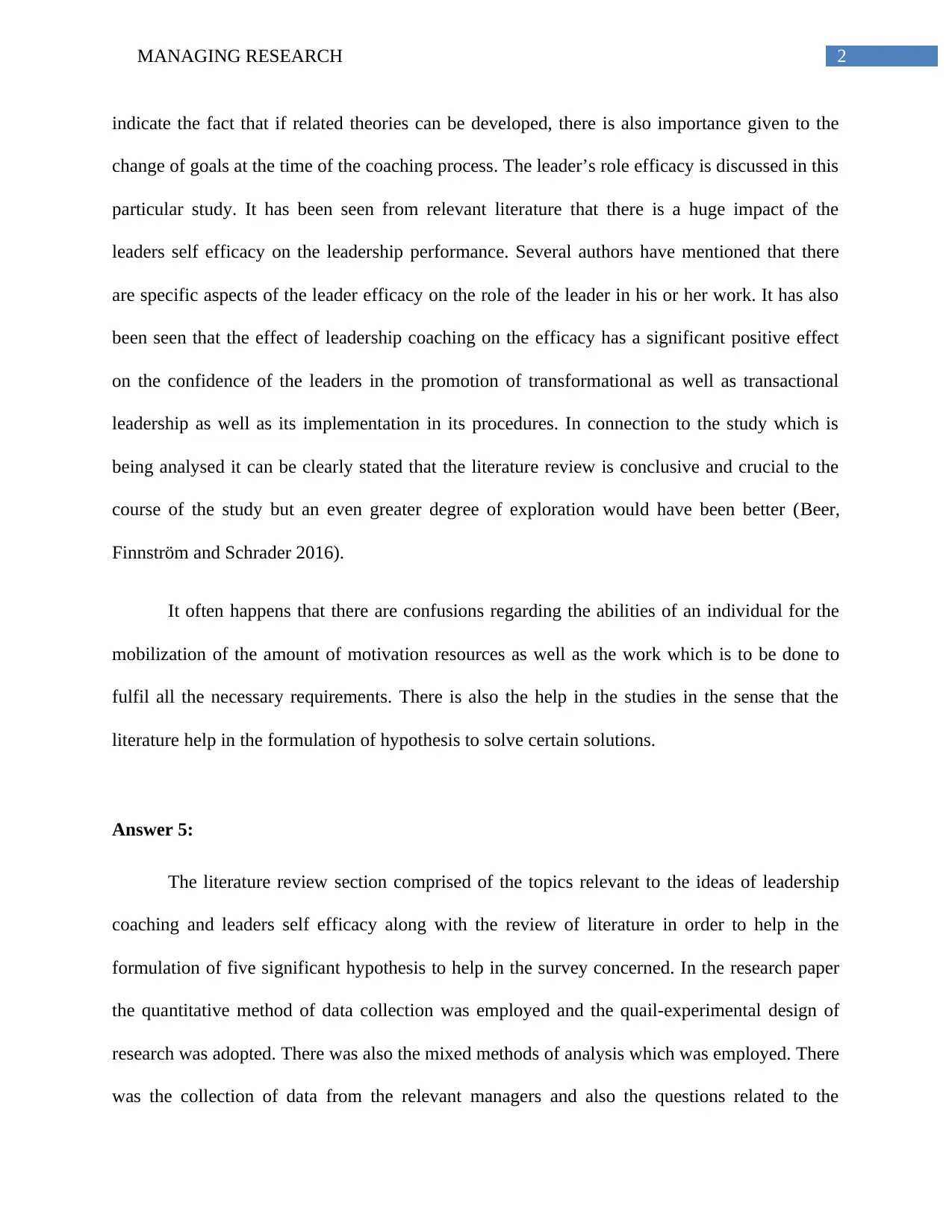
2MANAGING RESEARCH
indicate the fact that if related theories can be developed, there is also importance given to the
change of goals at the time of the coaching process. The leader’s role efficacy is discussed in this
particular study. It has been seen from relevant literature that there is a huge impact of the
leaders self efficacy on the leadership performance. Several authors have mentioned that there
are specific aspects of the leader efficacy on the role of the leader in his or her work. It has also
been seen that the effect of leadership coaching on the efficacy has a significant positive effect
on the confidence of the leaders in the promotion of transformational as well as transactional
leadership as well as its implementation in its procedures. In connection to the study which is
being analysed it can be clearly stated that the literature review is conclusive and crucial to the
course of the study but an even greater degree of exploration would have been better (Beer,
Finnström and Schrader 2016).
It often happens that there are confusions regarding the abilities of an individual for the
mobilization of the amount of motivation resources as well as the work which is to be done to
fulfil all the necessary requirements. There is also the help in the studies in the sense that the
literature help in the formulation of hypothesis to solve certain solutions.
Answer 5:
The literature review section comprised of the topics relevant to the ideas of leadership
coaching and leaders self efficacy along with the review of literature in order to help in the
formulation of five significant hypothesis to help in the survey concerned. In the research paper
the quantitative method of data collection was employed and the quail-experimental design of
research was adopted. There was also the mixed methods of analysis which was employed. There
was the collection of data from the relevant managers and also the questions related to the
indicate the fact that if related theories can be developed, there is also importance given to the
change of goals at the time of the coaching process. The leader’s role efficacy is discussed in this
particular study. It has been seen from relevant literature that there is a huge impact of the
leaders self efficacy on the leadership performance. Several authors have mentioned that there
are specific aspects of the leader efficacy on the role of the leader in his or her work. It has also
been seen that the effect of leadership coaching on the efficacy has a significant positive effect
on the confidence of the leaders in the promotion of transformational as well as transactional
leadership as well as its implementation in its procedures. In connection to the study which is
being analysed it can be clearly stated that the literature review is conclusive and crucial to the
course of the study but an even greater degree of exploration would have been better (Beer,
Finnström and Schrader 2016).
It often happens that there are confusions regarding the abilities of an individual for the
mobilization of the amount of motivation resources as well as the work which is to be done to
fulfil all the necessary requirements. There is also the help in the studies in the sense that the
literature help in the formulation of hypothesis to solve certain solutions.
Answer 5:
The literature review section comprised of the topics relevant to the ideas of leadership
coaching and leaders self efficacy along with the review of literature in order to help in the
formulation of five significant hypothesis to help in the survey concerned. In the research paper
the quantitative method of data collection was employed and the quail-experimental design of
research was adopted. There was also the mixed methods of analysis which was employed. There
was the collection of data from the relevant managers and also the questions related to the
⊘ This is a preview!⊘
Do you want full access?
Subscribe today to unlock all pages.

Trusted by 1+ million students worldwide
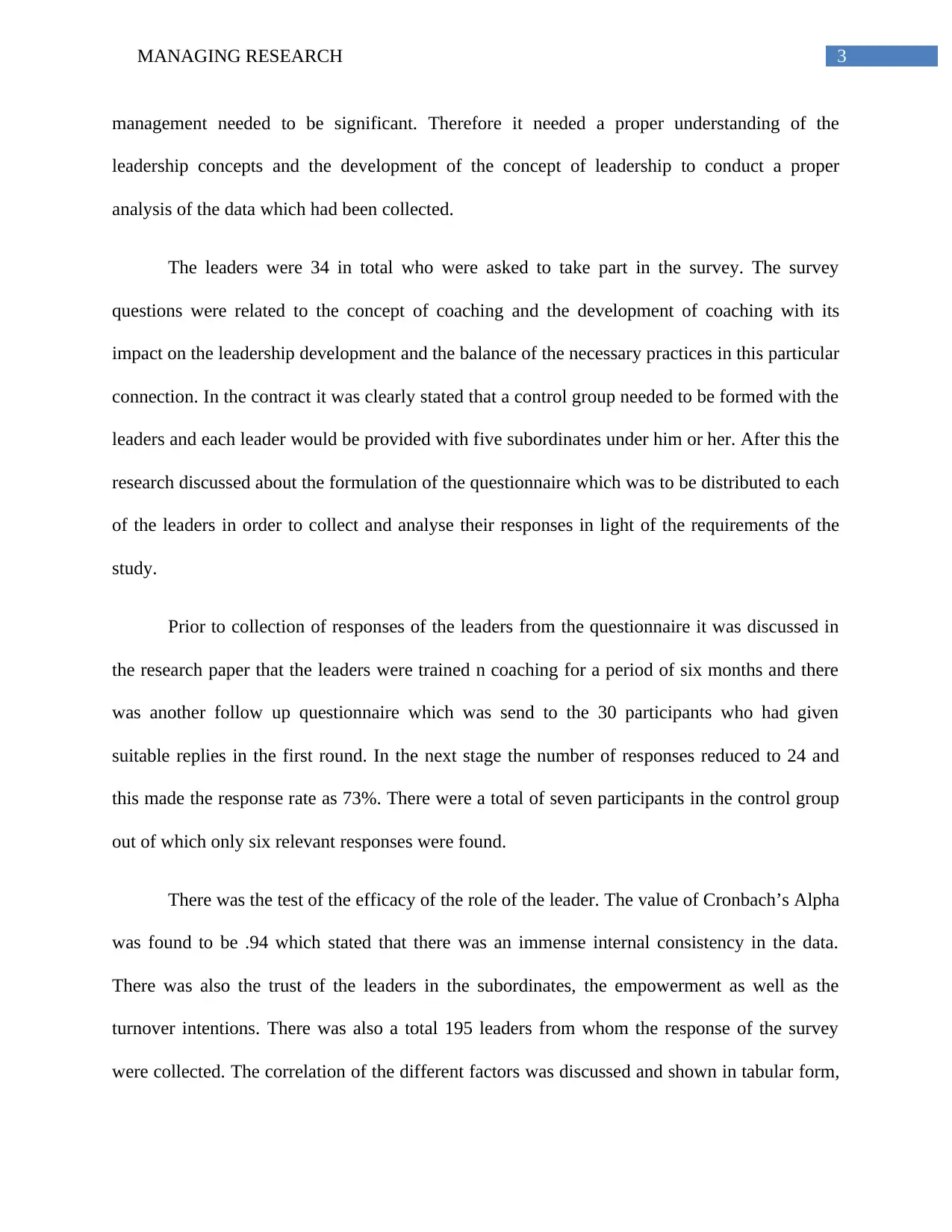
3MANAGING RESEARCH
management needed to be significant. Therefore it needed a proper understanding of the
leadership concepts and the development of the concept of leadership to conduct a proper
analysis of the data which had been collected.
The leaders were 34 in total who were asked to take part in the survey. The survey
questions were related to the concept of coaching and the development of coaching with its
impact on the leadership development and the balance of the necessary practices in this particular
connection. In the contract it was clearly stated that a control group needed to be formed with the
leaders and each leader would be provided with five subordinates under him or her. After this the
research discussed about the formulation of the questionnaire which was to be distributed to each
of the leaders in order to collect and analyse their responses in light of the requirements of the
study.
Prior to collection of responses of the leaders from the questionnaire it was discussed in
the research paper that the leaders were trained n coaching for a period of six months and there
was another follow up questionnaire which was send to the 30 participants who had given
suitable replies in the first round. In the next stage the number of responses reduced to 24 and
this made the response rate as 73%. There were a total of seven participants in the control group
out of which only six relevant responses were found.
There was the test of the efficacy of the role of the leader. The value of Cronbach’s Alpha
was found to be .94 which stated that there was an immense internal consistency in the data.
There was also the trust of the leaders in the subordinates, the empowerment as well as the
turnover intentions. There was also a total 195 leaders from whom the response of the survey
were collected. The correlation of the different factors was discussed and shown in tabular form,
management needed to be significant. Therefore it needed a proper understanding of the
leadership concepts and the development of the concept of leadership to conduct a proper
analysis of the data which had been collected.
The leaders were 34 in total who were asked to take part in the survey. The survey
questions were related to the concept of coaching and the development of coaching with its
impact on the leadership development and the balance of the necessary practices in this particular
connection. In the contract it was clearly stated that a control group needed to be formed with the
leaders and each leader would be provided with five subordinates under him or her. After this the
research discussed about the formulation of the questionnaire which was to be distributed to each
of the leaders in order to collect and analyse their responses in light of the requirements of the
study.
Prior to collection of responses of the leaders from the questionnaire it was discussed in
the research paper that the leaders were trained n coaching for a period of six months and there
was another follow up questionnaire which was send to the 30 participants who had given
suitable replies in the first round. In the next stage the number of responses reduced to 24 and
this made the response rate as 73%. There were a total of seven participants in the control group
out of which only six relevant responses were found.
There was the test of the efficacy of the role of the leader. The value of Cronbach’s Alpha
was found to be .94 which stated that there was an immense internal consistency in the data.
There was also the trust of the leaders in the subordinates, the empowerment as well as the
turnover intentions. There was also a total 195 leaders from whom the response of the survey
were collected. The correlation of the different factors was discussed and shown in tabular form,
Paraphrase This Document
Need a fresh take? Get an instant paraphrase of this document with our AI Paraphraser
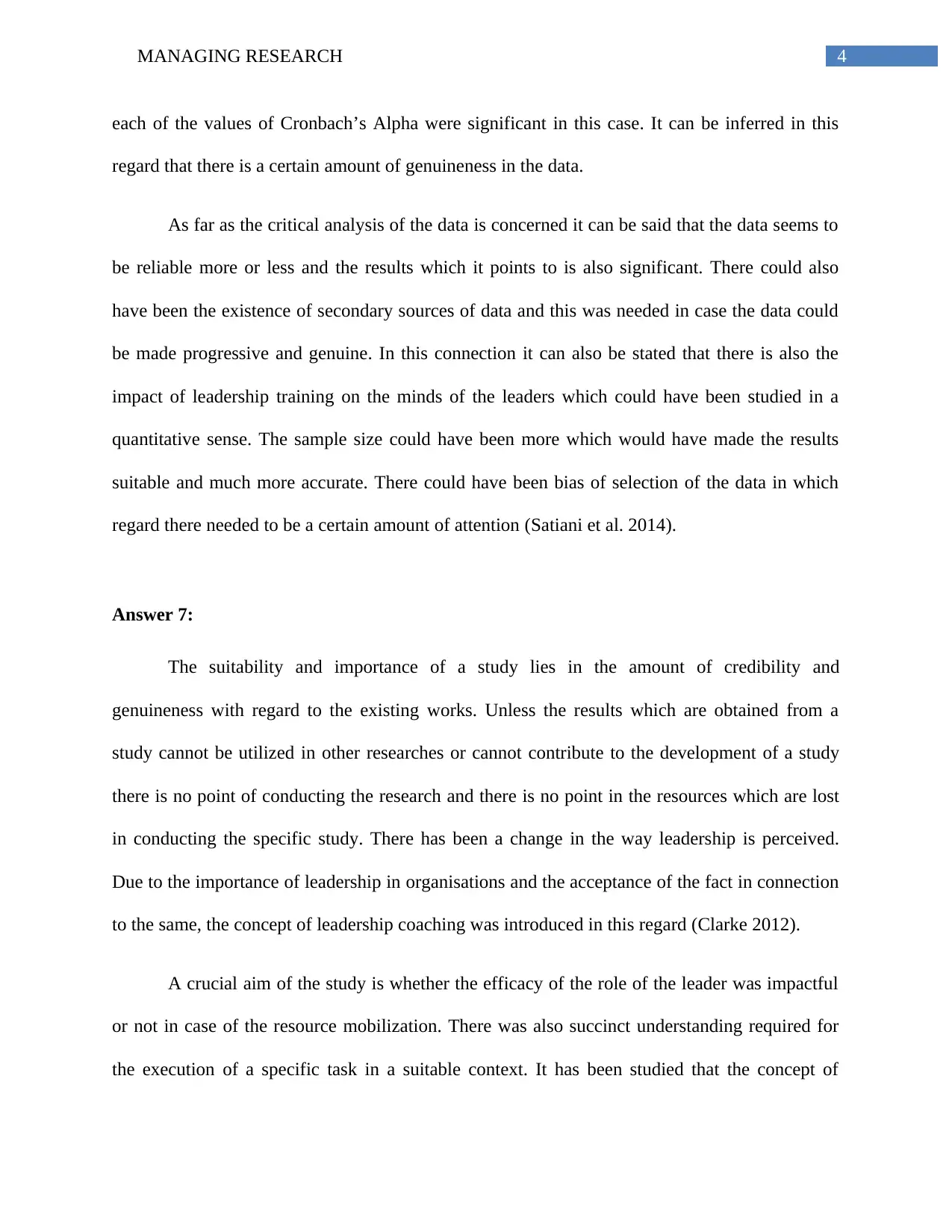
4MANAGING RESEARCH
each of the values of Cronbach’s Alpha were significant in this case. It can be inferred in this
regard that there is a certain amount of genuineness in the data.
As far as the critical analysis of the data is concerned it can be said that the data seems to
be reliable more or less and the results which it points to is also significant. There could also
have been the existence of secondary sources of data and this was needed in case the data could
be made progressive and genuine. In this connection it can also be stated that there is also the
impact of leadership training on the minds of the leaders which could have been studied in a
quantitative sense. The sample size could have been more which would have made the results
suitable and much more accurate. There could have been bias of selection of the data in which
regard there needed to be a certain amount of attention (Satiani et al. 2014).
Answer 7:
The suitability and importance of a study lies in the amount of credibility and
genuineness with regard to the existing works. Unless the results which are obtained from a
study cannot be utilized in other researches or cannot contribute to the development of a study
there is no point of conducting the research and there is no point in the resources which are lost
in conducting the specific study. There has been a change in the way leadership is perceived.
Due to the importance of leadership in organisations and the acceptance of the fact in connection
to the same, the concept of leadership coaching was introduced in this regard (Clarke 2012).
A crucial aim of the study is whether the efficacy of the role of the leader was impactful
or not in case of the resource mobilization. There was also succinct understanding required for
the execution of a specific task in a suitable context. It has been studied that the concept of
each of the values of Cronbach’s Alpha were significant in this case. It can be inferred in this
regard that there is a certain amount of genuineness in the data.
As far as the critical analysis of the data is concerned it can be said that the data seems to
be reliable more or less and the results which it points to is also significant. There could also
have been the existence of secondary sources of data and this was needed in case the data could
be made progressive and genuine. In this connection it can also be stated that there is also the
impact of leadership training on the minds of the leaders which could have been studied in a
quantitative sense. The sample size could have been more which would have made the results
suitable and much more accurate. There could have been bias of selection of the data in which
regard there needed to be a certain amount of attention (Satiani et al. 2014).
Answer 7:
The suitability and importance of a study lies in the amount of credibility and
genuineness with regard to the existing works. Unless the results which are obtained from a
study cannot be utilized in other researches or cannot contribute to the development of a study
there is no point of conducting the research and there is no point in the resources which are lost
in conducting the specific study. There has been a change in the way leadership is perceived.
Due to the importance of leadership in organisations and the acceptance of the fact in connection
to the same, the concept of leadership coaching was introduced in this regard (Clarke 2012).
A crucial aim of the study is whether the efficacy of the role of the leader was impactful
or not in case of the resource mobilization. There was also succinct understanding required for
the execution of a specific task in a suitable context. It has been studied that the concept of
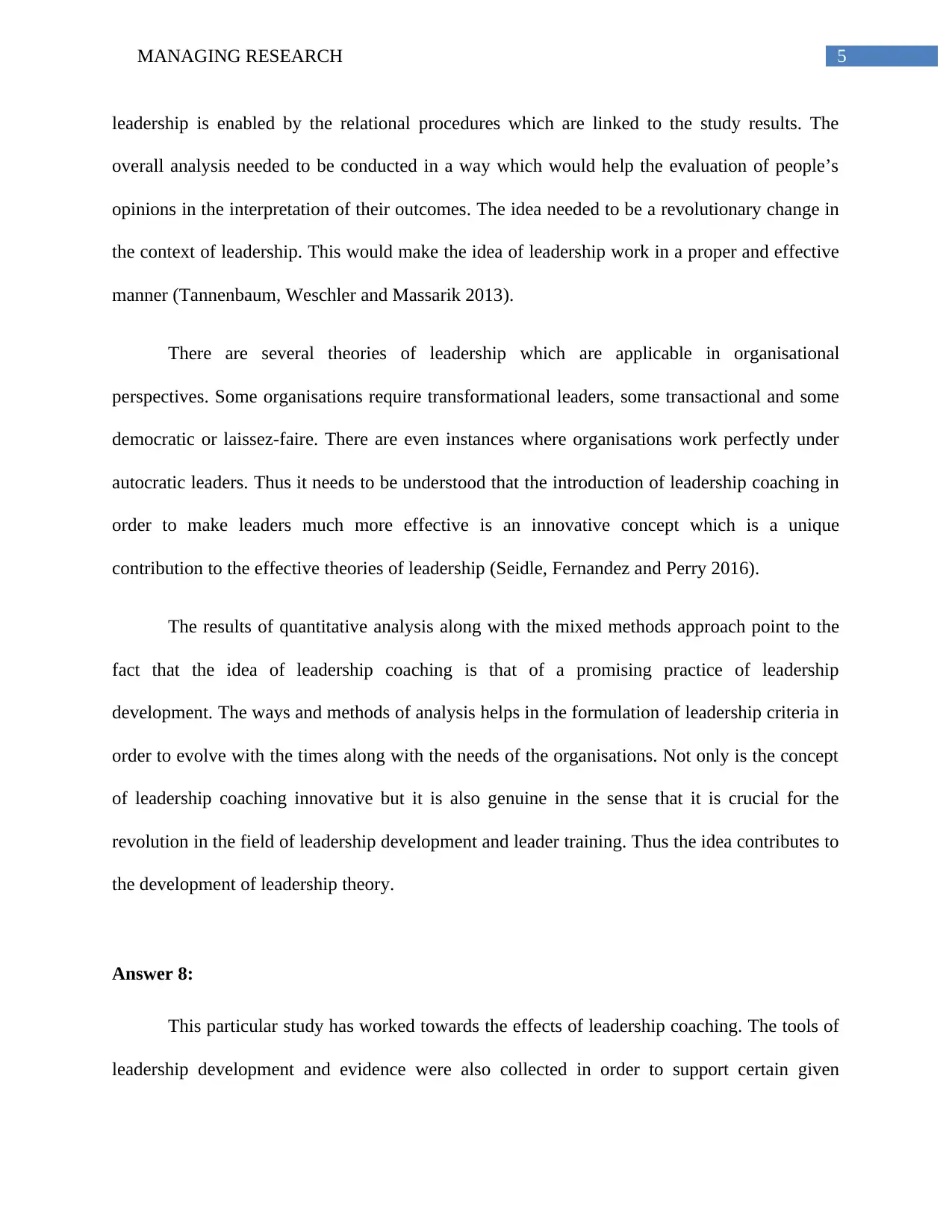
5MANAGING RESEARCH
leadership is enabled by the relational procedures which are linked to the study results. The
overall analysis needed to be conducted in a way which would help the evaluation of people’s
opinions in the interpretation of their outcomes. The idea needed to be a revolutionary change in
the context of leadership. This would make the idea of leadership work in a proper and effective
manner (Tannenbaum, Weschler and Massarik 2013).
There are several theories of leadership which are applicable in organisational
perspectives. Some organisations require transformational leaders, some transactional and some
democratic or laissez-faire. There are even instances where organisations work perfectly under
autocratic leaders. Thus it needs to be understood that the introduction of leadership coaching in
order to make leaders much more effective is an innovative concept which is a unique
contribution to the effective theories of leadership (Seidle, Fernandez and Perry 2016).
The results of quantitative analysis along with the mixed methods approach point to the
fact that the idea of leadership coaching is that of a promising practice of leadership
development. The ways and methods of analysis helps in the formulation of leadership criteria in
order to evolve with the times along with the needs of the organisations. Not only is the concept
of leadership coaching innovative but it is also genuine in the sense that it is crucial for the
revolution in the field of leadership development and leader training. Thus the idea contributes to
the development of leadership theory.
Answer 8:
This particular study has worked towards the effects of leadership coaching. The tools of
leadership development and evidence were also collected in order to support certain given
leadership is enabled by the relational procedures which are linked to the study results. The
overall analysis needed to be conducted in a way which would help the evaluation of people’s
opinions in the interpretation of their outcomes. The idea needed to be a revolutionary change in
the context of leadership. This would make the idea of leadership work in a proper and effective
manner (Tannenbaum, Weschler and Massarik 2013).
There are several theories of leadership which are applicable in organisational
perspectives. Some organisations require transformational leaders, some transactional and some
democratic or laissez-faire. There are even instances where organisations work perfectly under
autocratic leaders. Thus it needs to be understood that the introduction of leadership coaching in
order to make leaders much more effective is an innovative concept which is a unique
contribution to the effective theories of leadership (Seidle, Fernandez and Perry 2016).
The results of quantitative analysis along with the mixed methods approach point to the
fact that the idea of leadership coaching is that of a promising practice of leadership
development. The ways and methods of analysis helps in the formulation of leadership criteria in
order to evolve with the times along with the needs of the organisations. Not only is the concept
of leadership coaching innovative but it is also genuine in the sense that it is crucial for the
revolution in the field of leadership development and leader training. Thus the idea contributes to
the development of leadership theory.
Answer 8:
This particular study has worked towards the effects of leadership coaching. The tools of
leadership development and evidence were also collected in order to support certain given
⊘ This is a preview!⊘
Do you want full access?
Subscribe today to unlock all pages.

Trusted by 1+ million students worldwide
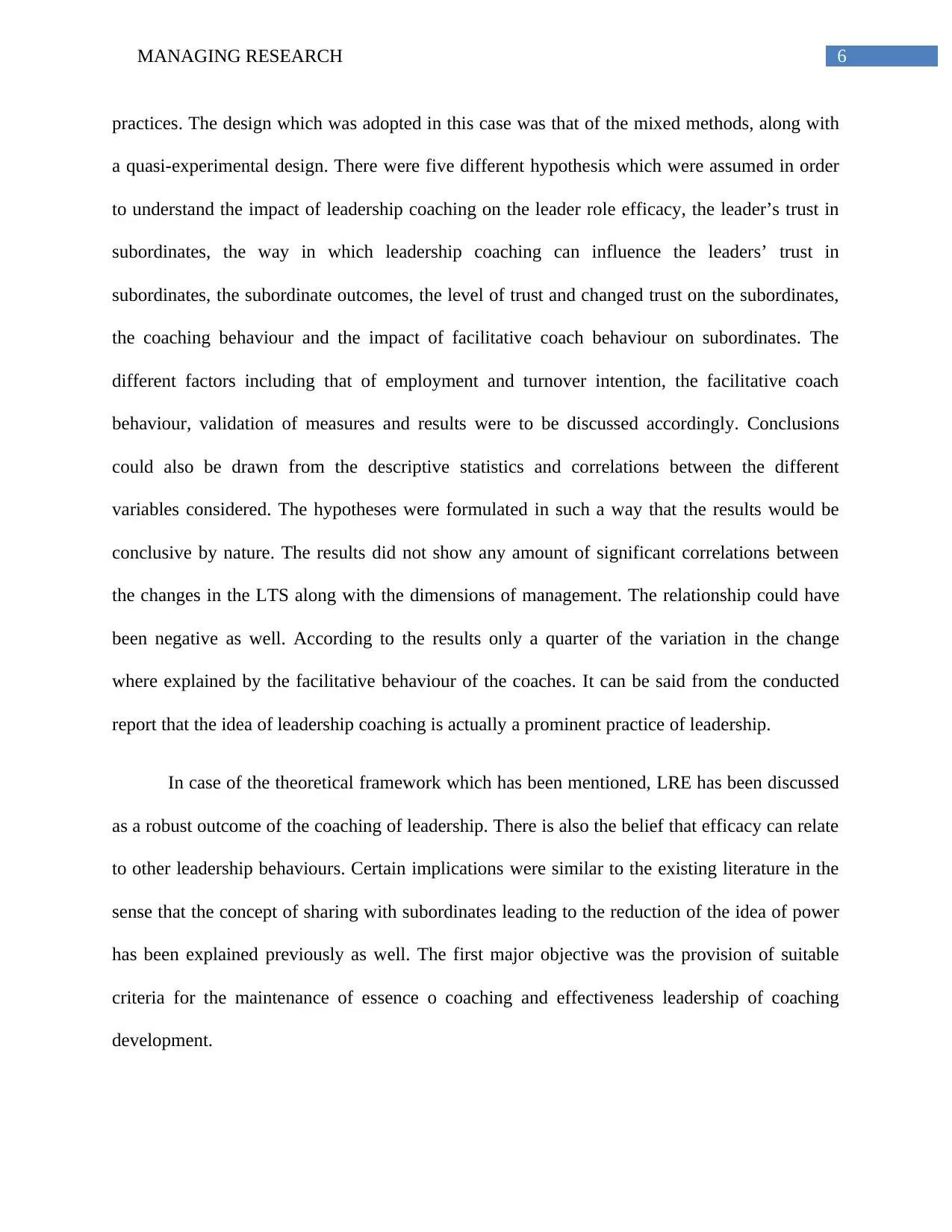
6MANAGING RESEARCH
practices. The design which was adopted in this case was that of the mixed methods, along with
a quasi-experimental design. There were five different hypothesis which were assumed in order
to understand the impact of leadership coaching on the leader role efficacy, the leader’s trust in
subordinates, the way in which leadership coaching can influence the leaders’ trust in
subordinates, the subordinate outcomes, the level of trust and changed trust on the subordinates,
the coaching behaviour and the impact of facilitative coach behaviour on subordinates. The
different factors including that of employment and turnover intention, the facilitative coach
behaviour, validation of measures and results were to be discussed accordingly. Conclusions
could also be drawn from the descriptive statistics and correlations between the different
variables considered. The hypotheses were formulated in such a way that the results would be
conclusive by nature. The results did not show any amount of significant correlations between
the changes in the LTS along with the dimensions of management. The relationship could have
been negative as well. According to the results only a quarter of the variation in the change
where explained by the facilitative behaviour of the coaches. It can be said from the conducted
report that the idea of leadership coaching is actually a prominent practice of leadership.
In case of the theoretical framework which has been mentioned, LRE has been discussed
as a robust outcome of the coaching of leadership. There is also the belief that efficacy can relate
to other leadership behaviours. Certain implications were similar to the existing literature in the
sense that the concept of sharing with subordinates leading to the reduction of the idea of power
has been explained previously as well. The first major objective was the provision of suitable
criteria for the maintenance of essence o coaching and effectiveness leadership of coaching
development.
practices. The design which was adopted in this case was that of the mixed methods, along with
a quasi-experimental design. There were five different hypothesis which were assumed in order
to understand the impact of leadership coaching on the leader role efficacy, the leader’s trust in
subordinates, the way in which leadership coaching can influence the leaders’ trust in
subordinates, the subordinate outcomes, the level of trust and changed trust on the subordinates,
the coaching behaviour and the impact of facilitative coach behaviour on subordinates. The
different factors including that of employment and turnover intention, the facilitative coach
behaviour, validation of measures and results were to be discussed accordingly. Conclusions
could also be drawn from the descriptive statistics and correlations between the different
variables considered. The hypotheses were formulated in such a way that the results would be
conclusive by nature. The results did not show any amount of significant correlations between
the changes in the LTS along with the dimensions of management. The relationship could have
been negative as well. According to the results only a quarter of the variation in the change
where explained by the facilitative behaviour of the coaches. It can be said from the conducted
report that the idea of leadership coaching is actually a prominent practice of leadership.
In case of the theoretical framework which has been mentioned, LRE has been discussed
as a robust outcome of the coaching of leadership. There is also the belief that efficacy can relate
to other leadership behaviours. Certain implications were similar to the existing literature in the
sense that the concept of sharing with subordinates leading to the reduction of the idea of power
has been explained previously as well. The first major objective was the provision of suitable
criteria for the maintenance of essence o coaching and effectiveness leadership of coaching
development.
Paraphrase This Document
Need a fresh take? Get an instant paraphrase of this document with our AI Paraphraser
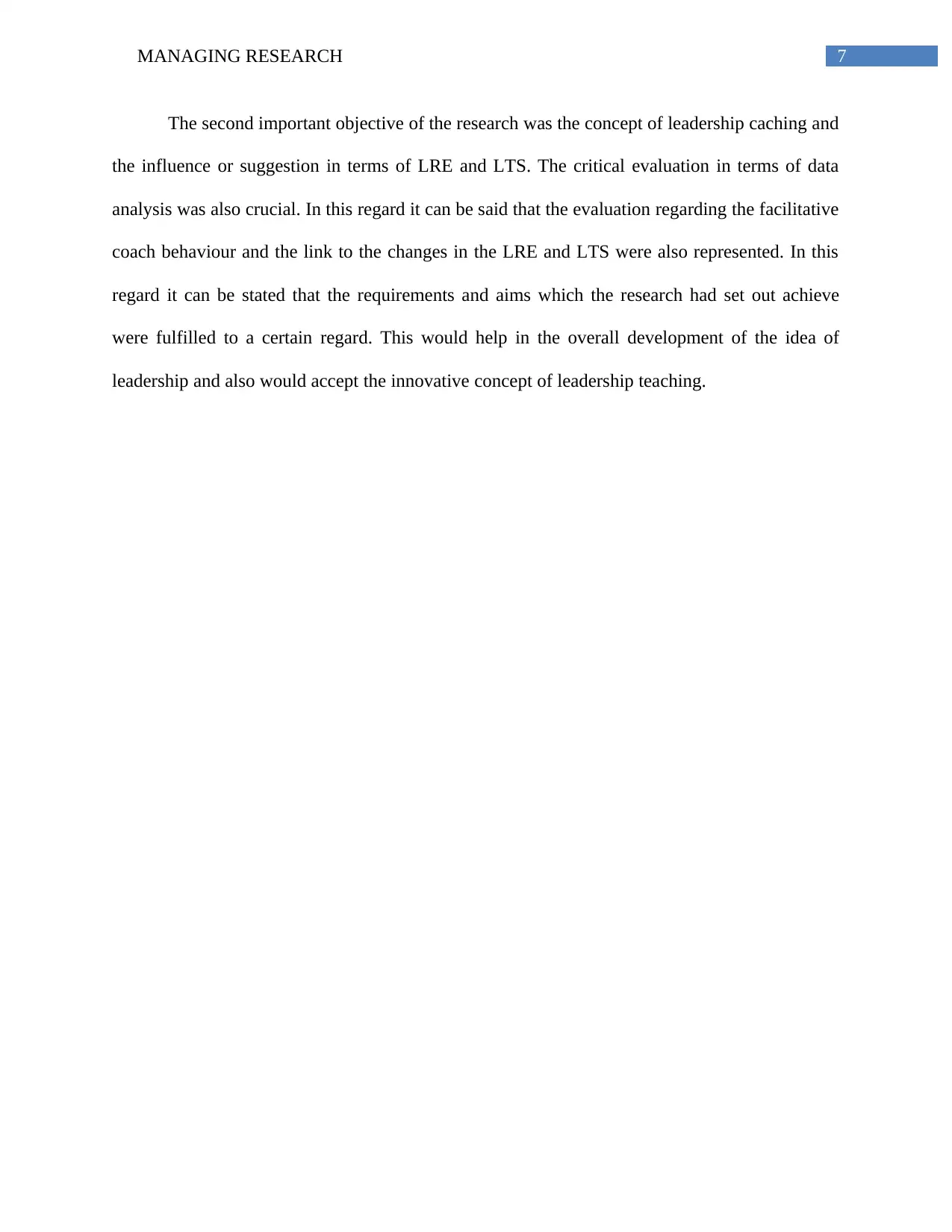
7MANAGING RESEARCH
The second important objective of the research was the concept of leadership caching and
the influence or suggestion in terms of LRE and LTS. The critical evaluation in terms of data
analysis was also crucial. In this regard it can be said that the evaluation regarding the facilitative
coach behaviour and the link to the changes in the LRE and LTS were also represented. In this
regard it can be stated that the requirements and aims which the research had set out achieve
were fulfilled to a certain regard. This would help in the overall development of the idea of
leadership and also would accept the innovative concept of leadership teaching.
The second important objective of the research was the concept of leadership caching and
the influence or suggestion in terms of LRE and LTS. The critical evaluation in terms of data
analysis was also crucial. In this regard it can be said that the evaluation regarding the facilitative
coach behaviour and the link to the changes in the LRE and LTS were also represented. In this
regard it can be stated that the requirements and aims which the research had set out achieve
were fulfilled to a certain regard. This would help in the overall development of the idea of
leadership and also would accept the innovative concept of leadership teaching.
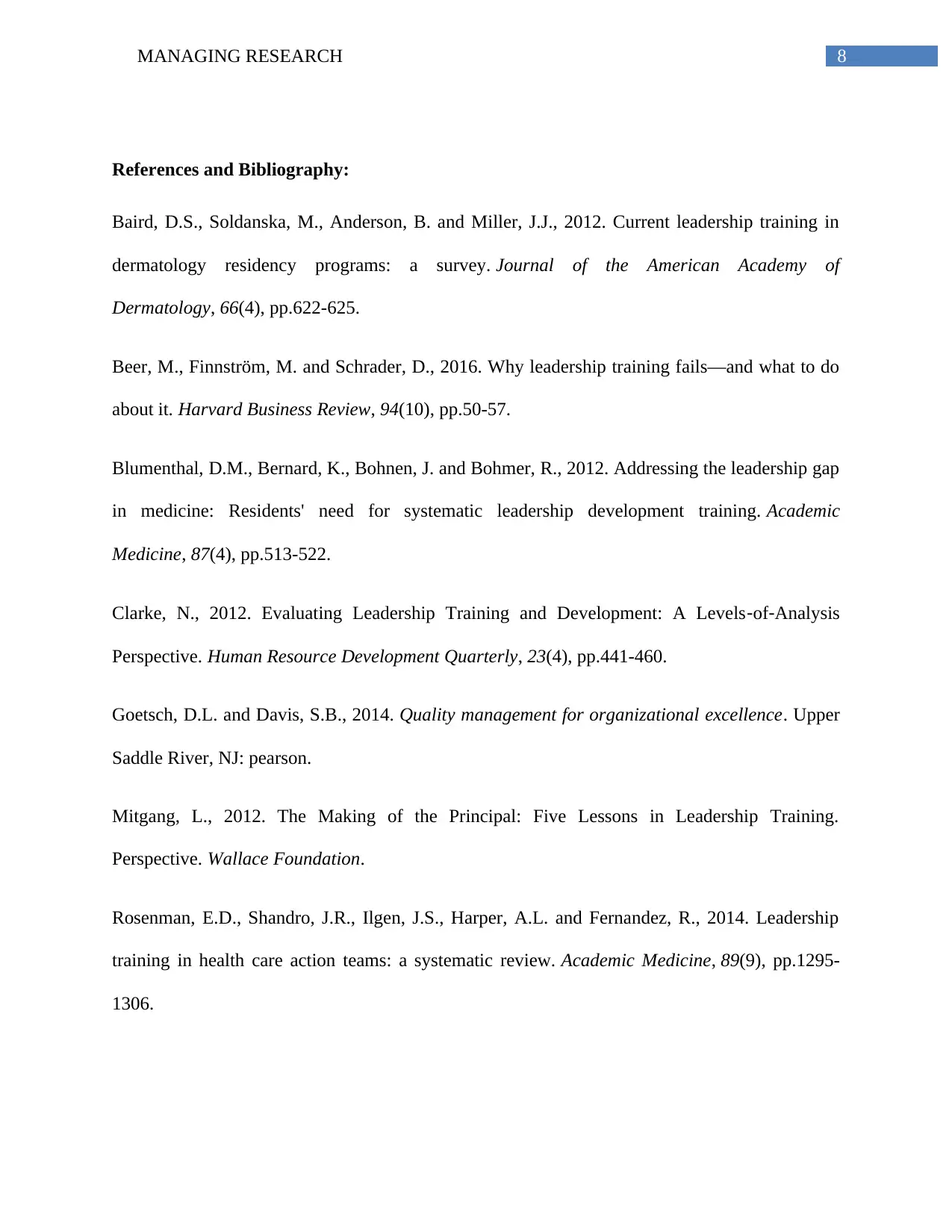
8MANAGING RESEARCH
References and Bibliography:
Baird, D.S., Soldanska, M., Anderson, B. and Miller, J.J., 2012. Current leadership training in
dermatology residency programs: a survey. Journal of the American Academy of
Dermatology, 66(4), pp.622-625.
Beer, M., Finnström, M. and Schrader, D., 2016. Why leadership training fails—and what to do
about it. Harvard Business Review, 94(10), pp.50-57.
Blumenthal, D.M., Bernard, K., Bohnen, J. and Bohmer, R., 2012. Addressing the leadership gap
in medicine: Residents' need for systematic leadership development training. Academic
Medicine, 87(4), pp.513-522.
Clarke, N., 2012. Evaluating Leadership Training and Development: A Levels‐of‐Analysis
Perspective. Human Resource Development Quarterly, 23(4), pp.441-460.
Goetsch, D.L. and Davis, S.B., 2014. Quality management for organizational excellence. Upper
Saddle River, NJ: pearson.
Mitgang, L., 2012. The Making of the Principal: Five Lessons in Leadership Training.
Perspective. Wallace Foundation.
Rosenman, E.D., Shandro, J.R., Ilgen, J.S., Harper, A.L. and Fernandez, R., 2014. Leadership
training in health care action teams: a systematic review. Academic Medicine, 89(9), pp.1295-
1306.
References and Bibliography:
Baird, D.S., Soldanska, M., Anderson, B. and Miller, J.J., 2012. Current leadership training in
dermatology residency programs: a survey. Journal of the American Academy of
Dermatology, 66(4), pp.622-625.
Beer, M., Finnström, M. and Schrader, D., 2016. Why leadership training fails—and what to do
about it. Harvard Business Review, 94(10), pp.50-57.
Blumenthal, D.M., Bernard, K., Bohnen, J. and Bohmer, R., 2012. Addressing the leadership gap
in medicine: Residents' need for systematic leadership development training. Academic
Medicine, 87(4), pp.513-522.
Clarke, N., 2012. Evaluating Leadership Training and Development: A Levels‐of‐Analysis
Perspective. Human Resource Development Quarterly, 23(4), pp.441-460.
Goetsch, D.L. and Davis, S.B., 2014. Quality management for organizational excellence. Upper
Saddle River, NJ: pearson.
Mitgang, L., 2012. The Making of the Principal: Five Lessons in Leadership Training.
Perspective. Wallace Foundation.
Rosenman, E.D., Shandro, J.R., Ilgen, J.S., Harper, A.L. and Fernandez, R., 2014. Leadership
training in health care action teams: a systematic review. Academic Medicine, 89(9), pp.1295-
1306.
⊘ This is a preview!⊘
Do you want full access?
Subscribe today to unlock all pages.

Trusted by 1+ million students worldwide
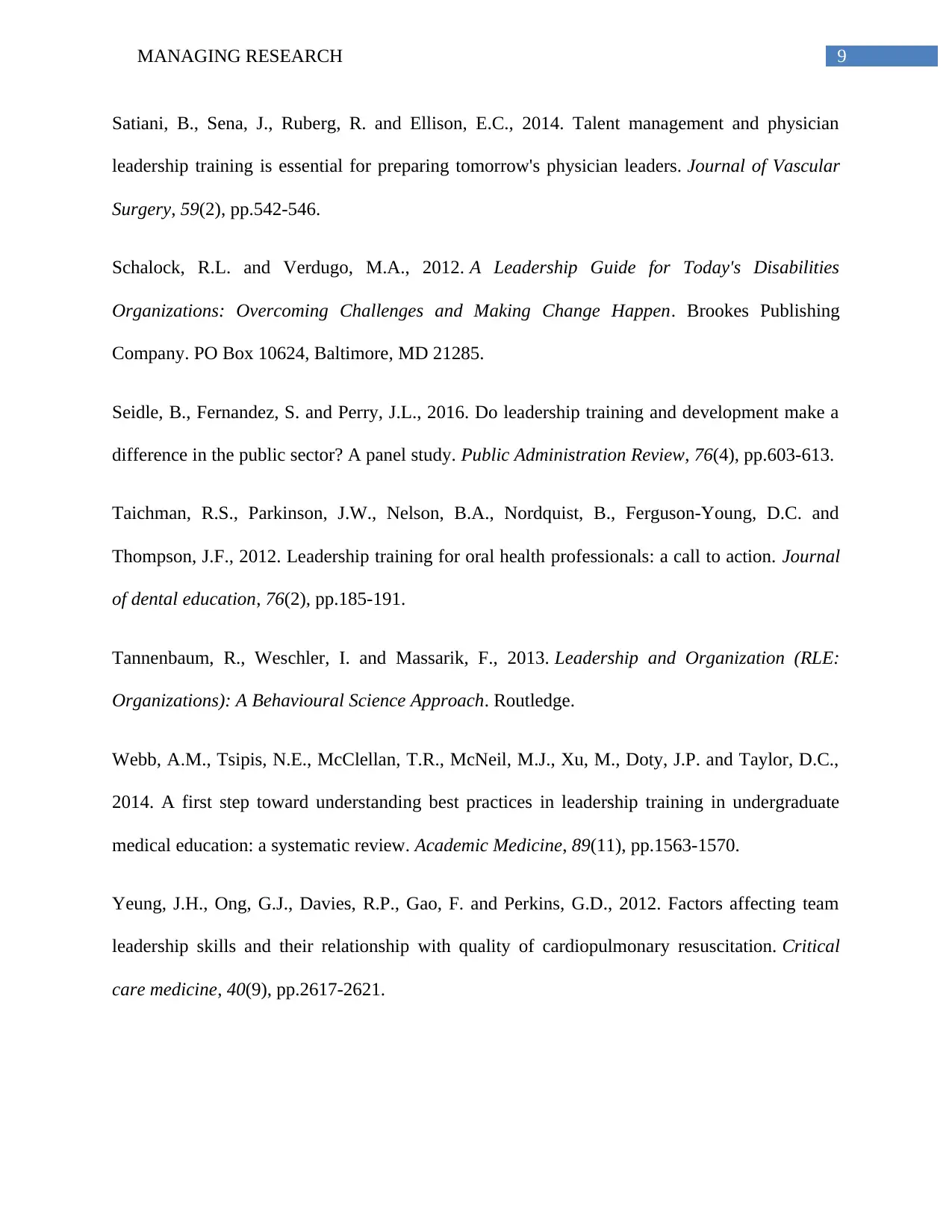
9MANAGING RESEARCH
Satiani, B., Sena, J., Ruberg, R. and Ellison, E.C., 2014. Talent management and physician
leadership training is essential for preparing tomorrow's physician leaders. Journal of Vascular
Surgery, 59(2), pp.542-546.
Schalock, R.L. and Verdugo, M.A., 2012. A Leadership Guide for Today's Disabilities
Organizations: Overcoming Challenges and Making Change Happen. Brookes Publishing
Company. PO Box 10624, Baltimore, MD 21285.
Seidle, B., Fernandez, S. and Perry, J.L., 2016. Do leadership training and development make a
difference in the public sector? A panel study. Public Administration Review, 76(4), pp.603-613.
Taichman, R.S., Parkinson, J.W., Nelson, B.A., Nordquist, B., Ferguson-Young, D.C. and
Thompson, J.F., 2012. Leadership training for oral health professionals: a call to action. Journal
of dental education, 76(2), pp.185-191.
Tannenbaum, R., Weschler, I. and Massarik, F., 2013. Leadership and Organization (RLE:
Organizations): A Behavioural Science Approach. Routledge.
Webb, A.M., Tsipis, N.E., McClellan, T.R., McNeil, M.J., Xu, M., Doty, J.P. and Taylor, D.C.,
2014. A first step toward understanding best practices in leadership training in undergraduate
medical education: a systematic review. Academic Medicine, 89(11), pp.1563-1570.
Yeung, J.H., Ong, G.J., Davies, R.P., Gao, F. and Perkins, G.D., 2012. Factors affecting team
leadership skills and their relationship with quality of cardiopulmonary resuscitation. Critical
care medicine, 40(9), pp.2617-2621.
Satiani, B., Sena, J., Ruberg, R. and Ellison, E.C., 2014. Talent management and physician
leadership training is essential for preparing tomorrow's physician leaders. Journal of Vascular
Surgery, 59(2), pp.542-546.
Schalock, R.L. and Verdugo, M.A., 2012. A Leadership Guide for Today's Disabilities
Organizations: Overcoming Challenges and Making Change Happen. Brookes Publishing
Company. PO Box 10624, Baltimore, MD 21285.
Seidle, B., Fernandez, S. and Perry, J.L., 2016. Do leadership training and development make a
difference in the public sector? A panel study. Public Administration Review, 76(4), pp.603-613.
Taichman, R.S., Parkinson, J.W., Nelson, B.A., Nordquist, B., Ferguson-Young, D.C. and
Thompson, J.F., 2012. Leadership training for oral health professionals: a call to action. Journal
of dental education, 76(2), pp.185-191.
Tannenbaum, R., Weschler, I. and Massarik, F., 2013. Leadership and Organization (RLE:
Organizations): A Behavioural Science Approach. Routledge.
Webb, A.M., Tsipis, N.E., McClellan, T.R., McNeil, M.J., Xu, M., Doty, J.P. and Taylor, D.C.,
2014. A first step toward understanding best practices in leadership training in undergraduate
medical education: a systematic review. Academic Medicine, 89(11), pp.1563-1570.
Yeung, J.H., Ong, G.J., Davies, R.P., Gao, F. and Perkins, G.D., 2012. Factors affecting team
leadership skills and their relationship with quality of cardiopulmonary resuscitation. Critical
care medicine, 40(9), pp.2617-2621.
Paraphrase This Document
Need a fresh take? Get an instant paraphrase of this document with our AI Paraphraser

10MANAGING RESEARCH
1 out of 11
Related Documents
Your All-in-One AI-Powered Toolkit for Academic Success.
+13062052269
info@desklib.com
Available 24*7 on WhatsApp / Email
![[object Object]](/_next/static/media/star-bottom.7253800d.svg)
Unlock your academic potential
Copyright © 2020–2025 A2Z Services. All Rights Reserved. Developed and managed by ZUCOL.



